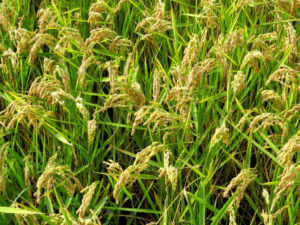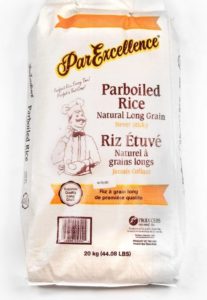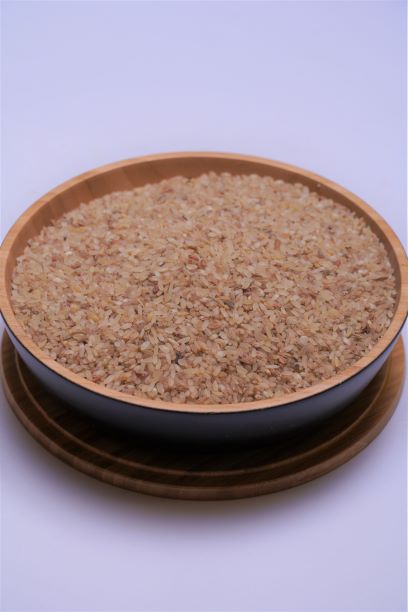
When rice is harvested, its inedible hull is removed to produce brown rice. The second step of processing to remove the bran produces white rice. Unlike brown and white rice, parboiled rice production begins before the hull is removed. The complete grain of rice is soaked, steamed and dried, and then the hull is removed to produce parboiled rice. The steaming enables the rice to absorb nutrients and changes the starch so that it cooks into a firmer, less sticky dish of rice than regular white rice. The steaming does not precook the rice, so it still takes about 20 minutes to prepare.
Carbohydrates
One cup of cooked parboiled rice provides 41 grams of total carbohydrates, or about one-third of the recommended daily intake of 130 grams. The same portion has 1.4 grams of fiber, which supplies 4 percent of men’s and 6 percent of women’s daily fiber. Parboiled rice has double the fiber than you’d get from cooked white rice. It has a low glycemic score of 38, compared with a high 89 for white rice, notes Harvard Health Publications. A low glycemic score indicates that the carbohydrates in parboiled rice do not cause a large spike in blood sugar.
B Vitamins
Parboiled rice is especially rich in niacin, providing 4 milligrams, or 23 percent of the recommended daily intake in 1 cup of cooked rice. You’ll also get 19 percent of the daily intake of vitamin B-6. These values are about double the amount you would get from non-enriched white rice. Your body needs B vitamins to metabolize food into energy, but they also fill other roles, such as helping make hormones and neurotransmitters. Vitamin B-6 removes the amino acid homocysteine from your bloodstream by turning it into other substances. This might help keep your heart healthy; high levels of homocysteine are associated with an increased risk of cardiovascular disease.
Minerals
One cup of cooked parboiled rice supplies 2 to 3 percent of the recommended daily intake of calcium, iron, magnesium and potassium. You’ll get a slightly bigger boost of zinc, with 1 cup containing 0.58 milligrams of zinc. That amount represents 5 percent of men’s and 7 percent of women’s daily needs. Zinc performs vital roles throughout your body, from forming the structure of proteins to regulating DNA. If you don’t get enough zinc, your immune system becomes impaired; the human body needs zinc to produce the cells that fight bacteria and infections.
Measurements:
To Prepare Number of Servings (Each serving yields approximately 1 cup cooked rice.): 2 Servings: 1/2 cup uncooked rice; 1-1/3 cups water; 1/4 tsp salt (optional); 2 tsp butter. margarine or oil (optional). 4 Servings: 1 cup uncooked rice; 2-1/4 cups water; 1/2 tsp salt (optional); 1 tsp butter. margarine or oil (optional). 6 Servings: 1-1/2 cup uncooked rice; 3-1/3 cups water; 3/4 tsp salt (optional); 1-1/2 tsp butter. margarine or oil (optional). 8 Servings: 2 cup uncooked rice; 4-1/2 cups water; 1 tsp salt (optional); 2 tsp butter. margarine or oil (optional). 10 Servings: 2-1/2 cup uncooked rice; 5-2/3 cups water; 1 tsp salt (optional); 2-1/2 tsp butter. margarine or oil (optional).
To Cook: To retain vitamins do not rinse before or after cooking. Stove Top: Step 1: In a saucepan combine water and ParExcellence Natural Long Grain Parboiled Rice. Add butter, margarine or oil and salt, if desired. Bring to a boil. Step 2: Reduce heat to low, cover tightly, and simmer 20-25 minutes or until most of the water is absorbed. Do not lift lid while cooking. Step 3: Remove from heat. Fluff with a fork before serving.
To Microwave: Step 1: Combine water and ParExcellence Natural Long Grain Parboiled Rice in a microwave safe container. Add butter, margarine or oil and salt, if desired. Bring to a boil. Step 2: Cover and cook on medium (50%) power for 20-25 (microwave ovens vary so cooking times given are approximate) minutes. Step 3 remove from microwave. Let stand covered for 5 minutes.

African and Carribean Foods, Imported to Canada
Ugonwa’s® is a specialty retail (online and store-front), with a great variety of African-Caribbean top-quality, kosher/halal meats and fishes, wholesome staple foods and produce, as well as authentic Afro-Caribbean fashion and Arts. Our niche spans across North America and the global market.


